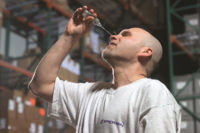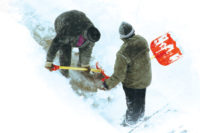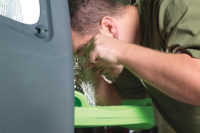Vision is among our primary means of experiencing the world, and the eyes with which we see are highly complex organs. Comprised of approximately 40 components and 10 million receptors, the human eye also maintains a delicate pH balance. It is not surprising then that something so intricate is also extremely vulnerable to injury. From contact with dust, smoke or common chemicals to punctures from foreign objects, the eye can easily be compromised in nearly any environment.
The effects of eye injuries range from minor irritation to short-term or even permanent vision loss. The cost of lost vision to an individual, including diminished quality of life and the reduced capacity to earn a living, is enormous. The cost of an eye injury to an employer is also significant. According to the National Safety Council, the average lost-time eye injury costs an employer roughly $30,000.
Improvements in workplace safety programs are helping reduce the number of occupational eye injuries. Still, more than 2,000 occur daily, according to Prevent Blindness America, and 10 to 20 percent of those injuries result in temporary or permanent vision loss. When an injury occurs, it is important that the eye be treated immediately — and properly — to ensure the best possible outcome.
Secondary (or personal) eyewash bottles can be conveniently located at the site of any eye hazard to provide immediate flushing. Useful in the presence of nuisance particles and irritants such as chemicals, fine debris and smoke, secondary bottles are also vital for delivering first aid while assisting a person to a primary eyewash unit and when transporting a person from primary eyewash to a medical facility.
Personal eyewash bottles are available in a variety of types and sizes as well as mounting systems, so they may be made readily available at the site of any hazard. It may be surprising to learn, however, that not all saline solution is the same, and that not all personal saline bottles are intended for use when flushing an injured eye. To safely and effectively treat workers’ eyes, safety managers should take into account the following considerations when choosing individual saline bottles to be used as secondary eyewash.
Secondary versus primary eyewash
The ANSI Z358.1-2009 standard for emergency eyewash states that secondary eyewash bottles are required at the site of nuisance particles such as pollen, dust, sawdust and smoke. They are also required where chemicals or other caustic substances exist, but among these hazards secondary bottles are to be used as supplemental equipment intended for immediate flushing — never as replacements for primary stations. When the eye is exposed to chemicals or other caustic substances, immediate flushing with secondary eyewash must be followed by the use of a primary emergency product capable of continuously delivering flushing fluid for a minimum of 15 minutes. In the case of contact with strong acids or alkalis, which can penetrate the cornea in as little as 45 seconds, secondary bottles provide vital treatment en route to the primary eyewash unit as well as continuous irrigation during transport to medical care.
Secondary eyewash systems can be as critical for the treatment of an injured eye as their primary counterparts. To determine whether chemical hazards require primary and/or secondary eyewash, consult their corresponding material safety data sheets in section four of the MSDS First Aid Measures, under the heading “eyes.”
Confirm bottles meet FDA requirements
While ANSI mandates the minimum performance and use requirements for emergency eyewash, the U.S. Food & Drug Administration (FDA) regulates the manufacture and contents of eyewash solution. The FDA requires that all fluid used to cleanse the eyes should be sterile and suitable for safe use in the eye. It also requires that containers of ophthalmic preparations be sterile at the time of filling and closing, and that containers be sealed so that the contents cannot be used without destroying the seal.
The manufacture of 100-percent sterile saline requires strict controls including a clean room environment and life cycle testing for stability in accordance with FDA guidelines. These requirements ensure that the saline is free from living bacteria, organisms and other contaminants and that it maintains such standards for the lifetime of the product. Be sure to check saline bottles and confirm that they are sterile and registered with the FDA as an ophthalmic preparation with a product NDC (National Drug Code).
Be sure saline is intended for ophthalmic use
When selecting bottles of saline for use as secondary eyewash, it is important to be aware of the differences between saline intended for ophthalmic use versus saline intended for topical use. The FDA requires that fluid intended for use in the eye must follow the ophthalmic preparations and dispensers’ regulation. The active ingredient must be sterile purified water and must be manufactured to match the natural pH of the eye. This protects and maintains the eye’s pH balance, which can be altered by chemicals, and ensures the saline will not cause further harm to the injured eye’s delicate tissue and lining. To ensure the saline bottles selected are approved for ophthalmic use, be sure bottle labeling identifies the product with one or more of the following terms: eyewash, eye irrigation or eye irrigating solution.
Select packaging based on your environment
It is also important to consider the type of secondary eyewash packaging. Per the FDA, packaging must be tamper-resistant or tamper-evident, meaning the package has one or more indicators or barriers to entry which, if breached or missing, provide visible evidence to consumers that tampering has occurred. Be sure that secondary eyewash bottles have tamper-evident features.
For cold weather locations, selecting the proper type of bottle is an especially important consideration. The two most common types of secondary eyewash bottles are screw cap and blow-fill seal cap. When saline inside a screw-cap bottle freezes, the frozen liquid will expand and may leak from the bottle. Once the solution reaches open air, screw-cap bottles are no longer considered sterile or safe to use, and must be discarded. If the potential for freezing conditions exists, whether in shipping, storage or on site, select bottles with blow-fill seal caps to prevent the possibility of leaks. Finally, it is important to check expiration dates on secondary eyewash bottles as part of effective overall eyewash maintenance.
Given the critical role vision plays in quality of life and our livelihoods, protecting workers’ eyes should be at the top of every safety manager’s list. Secondary eyewash is a vital part of an eye safety program and can improve critical response time and injury outcome. When selecting eyewash bottles, make sure they meet FDA requirements for sterile, ophthalmic-grade use and that the bottle design and size meet your site’s specific needs. Employers that choose the proper secondary eyewash can reduce the severity of eye injuries, helping save their employee’s vision and helping to reduce the cost of eye injuries — and that’s a clear win-win solution for everybody.







